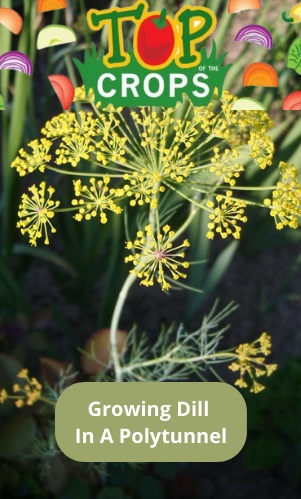Dill is a delicious, fragrant and versatile herb that can be used fresh in a number of different recipes. It is a great addition to a polytunnel because it is not only a good culinary herb, it can also be helpful to repel pests and attract beneficial insects to your polytunnel.
Dill, Anethum graveolens, is a herbaceous annual plant belonging to the celery family, Apiaceae. It is native to the Mediterranean region and southwestern Asia but is now cultivated in many parts of the world. Dill is prized for both its flavoursome leaves and its aromatic seeds.
The plant has finely divided, feathery leaves that are green in colour and resemble those of fennel. It produces small yellow flowers arranged in umbrella-like clusters known as umbels. These flowers eventually give way to seeds, which are used both as a spice and for their essential oil.
Dill has a distinctive flavour, often described as tangy, slightly sweet, and reminiscent of anise or licorice. It is commonly used as a culinary herb in various cuisines around the world, particularly in dishes from Eastern Europe, Scandinavia, and the Mediterranean region. Dill is often added to soups, salads, pickles, fish dishes, sauces, and dips, as well as used as a garnish.
In addition to its culinary uses, dill is also valued for its medicinal properties. It has been used traditionally as a digestive aid, to alleviate gas and bloating, and to stimulate appetite. Dill water, a solution made from dill seeds, is sometimes used to soothe infants with colic.
This herb can also be a useful companion plant for a range of other vegetable and fruit crops, and herbs. For example, dill can be a good trap crop for aphids and can also attract beneficial predatory insects.
| Jan | Feb | Mar | Apr | May | Jun | Jul | Aug | Sep | Oct | Nov | Dec | |
| Sow |  |
 |
 |
 |
||||||||
| Plant |  |
 |
 |
|||||||||
| Harvest |  |
 |
 |
 |
 |
Dill can be purchased in pots but is also very easy to grow from seed, and so it is worthwhile trying to do so since this is the more sustainable and eco-friendly choice. However, should you decide to purchase a dill plant rather than growing this herb yourself from seed, you can plant out between May and July.
Dill should be sown some time between April and July. Dill does not like its roots to be disturbed and so it is usually best to direct sow it in April where the plants are to grow. However, should you prefer, you can also sow indoors for later transplantation.
When direct sowing outdoors or in your polytunnel, sow thinly and just cover the seeds. The seeds are fairly easy to grow and do not take too long to germinate. Ideally, the soil temperature should be at 15 degrees C. or above for best germination rates. Seedlings should emerge within 10-14 days.
Since dill has a deep tap root kind of like a carrot, it does not take well to transplantation on the whole. However, if you plant into biodegradable modules or toilet roll tubes, and plant these into the garden, this helps to protect the roots and increase the chances of successful transplantation.
Take care when transplanting your biodegradable containers not to damage the young roots. And make sure that you choose a suitable growing location.
Dill is a tall herb and will look good at the back of your herb bed, or at the centre of a mixed polytunnel polyculture. Dill can also be grown in containers or in a dedicated herb garden such as a herb spiral.
Dill is not a challenging herb to care for, as long as you keep its basic care requirements in mind.
You should make sure to water regularly and not to let soil dry out entirely, but it is also important not to overwater. Remember that dill will likely need more frequent watering
Spread a generous layer of mulch, such as thoroughly decomposed manure or organic garden compost, around the base of the plants. This will assist in retaining soil moisture and discouraging weed growth.
Dill can become overtaken by weeds if you are not careful, so weed well around these plants to reduce the competition.
Dill typically reaches heights of at least 90cm (3ft), while taller varieties can potentially grow up to 150cm (5ft). To prevent them from flopping over or being knocked down by wind, it may be necessary to provide support using bamboo canes or twiggy sticks.
Alternatively, to maintain a more compact growth habit, regularly pinch out the growing tips or opt for a compact dill variety.
To focus on harvesting dill leaves and discourage the development of flowers or seeds, trim any emerging flower stalks to redirect the plant's energy towards producing new leaves. Delaying the onset of flowering will prolong the period for leaf harvesting.
If left unchecked, dill can become leggy and tall. To promote denser growth, regularly harvest the shoot tips or simply pinch them off.
Collect the dill seeds once they have ripened and dried, typically in late summer or autumn. Leaving the seeds in place will result in their scattering and often germination, leading to the growth of new plants.
You can then delicately dig up the young dill seedlings and transplant them to a suitable location if desired, taking care not to disrupt their roots as much as possible. Dill plants can often reliably self-seed in the right location.
Dill is most frequently grown for its leaves, which are often used in egg or fish dishes. You can cut leaves as and when they are required throughout the spring and summer months. Dill can be used fresh or frozen in a range of recipes, and though not at its best when dried, it is possible to dry dill for use over winter.
Dill seeds are also harvested. Harvest the seeds when they begin to turn brown and ripen in the late summer or early autumn. The seeds can be used ground or whole and are utilised for curries and for dill pickles.
Dill leaves are best used fresh, as soon as possible after picking but can also be frozen into ice-cube trays in blocks of water for later use.
To save the seeds, cut the stalks and put them in or on paper to dry fully. The seeds can then be removed from the stalk sections and when fully dried, can be stored in air-tight containers.
There are a number of dill varieties for UK growers to consider. These include:
'Fernleaf': This compact variety of dill is ideal for smaller gardens or container growing. It has a more dwarf habit, making it less prone to flopping over.
'Bouquet': Another popular variety, 'Bouquet' dill is known for its strong flavour and vigorous growth. It produces abundant foliage and is suitable for both culinary and ornamental purposes.
'Dukat': This variety is prized for its aromatic leaves and excellent flavour. It tends to bolt later than some other varieties, meaning it stays in the leaf-producing stage for a longer period.
'Long Island Mammoth': As the name suggests, this variety produces large, feathery foliage and can reach impressive heights. It's a traditional variety with robust growth and a classic dill flavour.
'Mammoth': Similar to 'Long Island Mammoth', this variety also produces large, flavourful leaves and is well-suited for use in pickling and culinary dishes.
Dill has a tendency to bolt, or prematurely flower, especially during hot and dry weather conditions. To prevent this, it's essential to ensure consistent watering, avoiding allowing the soil to dry out completely.
Since dill is a short-lived plant, it naturally transitions to flowering once it's well established, which diminishes leaf production. To maintain a continuous harvest of leaves, it's advisable to sow new batches of seeds every few weeks, replacing plants as they begin to flower. Utilizing successional sowing techniques can help achieve this goal effectively.
Additionally, you can prolong the leaf harvest period by promptly removing the flower stalks as soon as they begin to form.
While dill is relatively resilient to pests and diseases, there are a few issues to be mindful of:
Slugs and snails are attracted to the tender leaves of dill. Implementing deterrents or controls can help mitigate their presence.
Aphids may infest the shoots of dill plants.
Young dill plants are particularly vulnerable to both slugs and snails, as well as aphids, so it's important to monitor for signs of infestation and take appropriate action to protect the plants.
Remember, holistic organic pest management is the best approach and to keep pest numbers down you first and foremost need to ensure that you attract plenty of wildlife to your garden, so that natural predation can take place and keep things in balance and keep pest numbers under control.
Dill likes a location out of strong winds and a little sheltered, so growing it inside a polytunnel should be ideal. Remember, dill will be a beneficial addition to your polytunnel and may be of benefit to other plants growing close by, helping with holistic, organic pest control.
BBC Food. (2020) Dill Recipes. [online] Available at: https://www.bbc.co.uk/food/dill
McGrane, K., (2020) All You Need To Know About Dill. Healthline. [online] Available at: https://www.healthline.com/nutrition/dill
